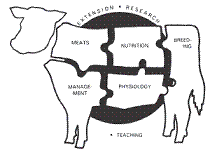Animal Science, Department of

Nebraska Beef Cattle Reports
Date of this Version
2020
Citation
Th e Board Regents of the University of Nebraska. All rights reserved.
Abstract
A modeling study evaluated the effects of milk production level on nutrient balance in May- calving cows grazing Sandhills upland range during the breeding season. Forage quality of upland range peaks in June and steadily declines in July until November. With timing of forage quality decline and increasing nutrient demands due to lactation, cows were in a negative energy balance in late June and early July prior to deficiency of metabolizable protein. Supplementation to meet energy deficiencies in June and July and MP deficiencies in July with distiller grains that is high ruminally undegradable protein and high fiber energy may be needed in May- calving cowherds. Selection for milk over 23 lb at peak lactation creates deficiencies early post- calving and increases the need for additional supplementation to correct the nutrient deficiency. In an effort to match cow type to environment in the Sandhills and optimize performance, producers should consider selecting against high milk potential.
Included in
Large or Food Animal and Equine Medicine Commons, Meat Science Commons, Veterinary Preventive Medicine, Epidemiology, and Public Health Commons


Comments
2020 Nebraska Beef Cattle Report